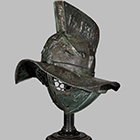Gladiators: Fact, fiction and surprise
August 26, 2015
Almost everyone is familiar with — and fascinated by — the brave warriors forced into mortal combat in ancient Roman arenas.
“Everybody loves gladiators,” says Dr. Peter MacLeod, a Canadian War Museum historian who helped adapt the exhibition for Canadian visitors. “How many people have seen Russell Crowe in the movie Gladiator or Kirk Douglas in Spartacus, read the comic book Asterix the Gladiator, or watched the Gladiators TV series?”
These popular depictions are exciting but also largely fictional, which is why Gladiators and the Colosseum – Death and Glory is such an eye-opener. The must-see exhibition takes visitors back to the great amphitheatre of ancient Rome to meet the real armed athletes who fought, often to the death, to entertain and inspire the masses.
The Canadian War Museum is the only North American venue for the exhibition, which was developed by the Italian firms Contemporanea Progetti and Expona.
“Pop culture has trivialized a complex social structure that has its roots in Greek death rituals and in Roman statements of power and spectacle,” says Dr. Rossella Rea, the Colosseum’s Archaeological Director, who jumped at the opportunity to curate Gladiators and the Colosseum – Death and Glory. “I felt it was time to sift through the truths and the myths, to separate fact from fiction, to clarify the historical and archaeological perspective of gladiators, and to show what the Colosseum really represents.”
“We have combined modern storytelling techniques with traditional archaeological motifs to accurately represent this ancient Mediterranean tradition and its connection to Rome’s militaristic culture,” explains Dr. Rea.
Meet the real gladiators
The exhibition presents priceless artifacts from the Colosseum, the Museo Archeologico Nazionale in Naples, the Museo Civico Archeologico in Bologna and the Römisch-Germanisches Zentralmuseum in Mainz, Germany. Highlights include a gladiator’s helmet and dagger preserved by volcanic ash from the eruption of Mount Vesuvius that destroyed Pompeii in AD 79, and a piece of a seat from the Colosseum carved with the image of a father and son holding hands.
Among the facts revealed in Gladiators and the Colosseum – Death and Glory: not all gladiators were slaves (some volunteered in exchange for money, food and a shot at glory), some were women (the exhibition includes a photograph of a monument to Amazonia and Achillea, two women who fought as heavily armoured provocatores) and all were vegetarians.
“Because of typical modern athletes’ diets, we automatically assume that gladiators would be gorging on meat,” MacLeod says. “Instead, they ate a very healthy vegetarian diet of beans, barley porridge and fresh vegetables. But it fits with the Roman tendency not to consume much meat.”
Gladiators and the Colosseum – Death and Glory will continue to surprise and enlighten visitors to the Canadian War Museum until September 7, 2015.
Image: Helmet, 1st century A.D., Naples, Museo Archeologico Nazionale
This gladiator helmet, found in a gladiator school buried by the volcanic eruption that destroyed Pompeii in A.D. 79, lacks the dents and scratches that would have come from actual use in combat.